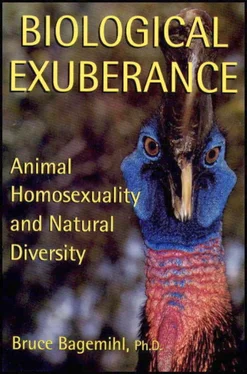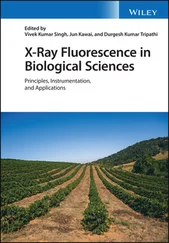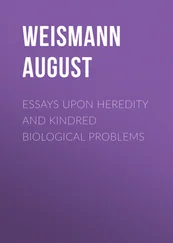If taken literally, the Wintu tribesman’s account is clearly the more “accurate” of the two: homosexuality and/or transgender occur in Grizzly and Black Bears, Salmon of various species, and several birds of prey (including Barn Owls, Powerful Owls, Kestrels, and Steller’s Sea Eagles). But that’s almost beside the point: what is most significant is the inclusiveness of his vision, which stands regardless of whether any animals he mentions are “known” by zoology to be homosexual or transgendered. It is not the “accuracy” of individual observations that validates an indigenous perspective, but the expansiveness of that perspective which fosters such “accurate” observations in the first place. What Western science can learn most from aboriginal cultures is precisely this polysexual, polygendered view of the natural world. The next section explores how these ideas can be incorporated in a more concrete fashion into scientific discourse and shows that they are fundamentally compatible with a number of new developments in science and philosophy.
A Revolution Under Way: Contemporary Scientific and Philosophical Perspectives
We need another and a wiser and perhaps a more mystical concept of animals…. They are not brethren, they are not underlings; they are other nations, caught with ourselves in the net of life and time, fellow prisoners of the splendor and travail of the earth.
—naturalist HENRY BESTON
In effect, chaos is life. All mess, all riot of color, all protoplasmic urgency, all movement —is chaos.
—essayist HAKIM BEY 83
Biology must reconsider functional explanations based on evolution by natural selection, and it must recognize the inherent multiplicity of all life forms. The existence of a natural phenomenon is its function—regardless of how strange, complex, or “unproductive” it may seem. These are just a sample of some of the revisionist ideas that are now being proposed in biology, in conjunction with work in a broad range of other scientific disciplines. Although none of these ideas has yet been applied to the understanding of homosexuality/transgender, they have powerful implications for our ways of seeing these phenomena. The synthesis of these new ideas—and their application to a broad spectrum of natural and cultural phenomena, including systems of gender and sexuality—we will call Biological Exuberance. Biological Exuberance is not a theory or an “explanation” designed to supplant previous ones; rather, it is a fundamental shift in perspective, an alternative vision of something we thought we understood. Through this concept, we seek not so much to add new facts to existing knowledge, but (as Robert Pirsig puts it) to add a new pattern of knowledge to existing facts. 84
In the following discussion, we will explore the potential inherent in certain contemporary scientific and philosophical perspectives to initiate such a re-visioning. Many of the ideas to be considered here are highly speculative or counter to traditional thinking, and often controversial even within their respective fields. Other, seemingly implausible, concepts will reveal themselves to be compatible with some of the most basic and long-standing concepts of orthodox biological theorizing. Moreover, each of the ideas to be discussed already represents a vast and complex field of knowledge; we can do no more than sketch the merest outlines of a road map for future investigation, suggesting some fruitful paths of inquiry. What the ideas we are conveniently summarizing under the rubric of Biological Exuberance have in common, though, is the capacity to precipitate a breakthrough in understanding (even when, by necessity, they are presented in abbreviated form). Taken together, they offer a new mode of perception, something infinitely more valuable than yet another simplistic “answer.” Where basic paradigm shifts are concerned, we should not be puzzled by how firmly we previously held to so many different falsehoods; rather, we should be astounded that there are so many different truths (to paraphrase James Carse). 85
Post-Darwinian Evolution and Chaotic Order
Nature… is fundamentally erratic, discontinuous, and unpredictable. It is full of seemingly random events that elude our models of how things are supposed to work.
—DONALD WORSTER, “The Ecology of Chaos and Harmony” 86
Survival of the fittest, natural selection, random genetic mutations, competition for resources—we all know how evolution works, right? Not quite. Over the past two decades, a quiet revolution has been taking place in biology. Some of the most fundamental concepts and principles in evolutionary theory are being questioned, challenged, reexamined, and (in some cases) abandoned altogether. A new paradigm is emerging: post-Darwinian evolution. 87“Heretical” ideas are being proposed by post-Darwinian evolutionists, such as the self-organization of life, the notion that the environment can beneficially alter the genetic code, and a suite of evolutionary processes to accompany the once hegemonic principle of natural selection. Moreover, many of the developments in this theorizing reflect surprising convergences with another “new” science, chaos theory.
“Put at its simplest, the new paradigm is an insistence on pluralism in evolutionary studies.” That’s how scientists Mae-Wan Ho and Peter Saunders characterize the essence of the new thinking on evolution. 88This paradigm is tackling a number of long-standing puzzles in biology—among them, global patterns of emergence and extinction of species, “mimicry” between animals separated by geography (in which two unrelated butterfly species in different parts of the world, for example, have evolved identical appearances), and convergence between the structure of biological and inorganic forms (in which jellyfish larvae, for instance, closely resemble the patterns made by falling drops of ink in water; or the similarity between animal coat markings and the standing wave patterns that can be generated on thin, vibrating plates). Post-Darwinian evolutionary biologists are synthesizing developments in a number of diverse disciplines such as physics, chemistry, mathematics, and molecular and developmental biology as part of their theorizing on these and other phenomena.
One proposal involves the possibility of the self-organization of life—the notion that the proteins, and in turn the enzymes and the cells, necessary for the first rudimentary life-forms may not have arisen randomly. Rather, experiments have shown that such building blocks can form “spontaneously” through the interaction of chemical and physical processes inherent in the molecules themselves and their watery medium. Similarly, convergences in form between distant species or organic and inorganic matter reveal underlying patterning processes that may actually “direct” evolutionary change. Another revolutionary proposal involves what is known as the “fluid genome”: the hypothesis that the environment can beneficially change the genes of an organism. The genetic code was previously thought to be static and inalterable (aside from random mutations), but now biologists are recognizing that a dynamic, complex, two-way interaction between environment and genetics may occur, possibly even leading to the evolution of new species. 89
Although much of this theorizing is admittedly in its infancy (and even, in a few cases, on the “fringes” of the scientific establishment), some of the most respected names in evolutionary science are participating in the reevaluation of basic tenets of the theory. 90World-renowned biologist and evolutionist Edward O. Wilson is at the forefront of the discussion, even going so far as to declare that evolution is, in a sense, a form of religion—“The evolutionary epic is probably the best myth we will ever have” 91—thereby putting an ironic twist on the whole creationism-evolution controversy. Perhaps what is most significant in this entire discussion is not the explanatory power of particular theories (impressive as some of these are), but the spirit of intellectual openness and vision being embraced by many evolutionists, the willingness to reexamine once ironclad principles. Nowhere is this more apparent than in the questioning of the basic principle of natural selection based on random genetic variations. A number of scientists—among them Stephen Jay Gould—have long criticized the attempt to find an adaptive explanation for “every surviving form, structure, or behavior—however bizarre, unnecessarily complex or outright crazy it may appear.” 92Of course, the limitations of such “adaptationist” explanations are precisely the problem that orthodox biology confronts when it looks at the “bizarre” behaviors of homosexuality and nonreproductive heterosexuality. If biology is finally to come to terms with these phenomena, such explanations will need to be seriously reevaluated.
Читать дальше












